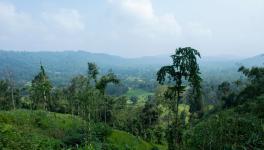Massive Decrease in Guwahati’s Forest Cover Since 1976

Representational Image. Image Courtesy: Pexels
The forest cover of the Guwahati Metropolitan Area (GMA) alarmingly declined from 1976 to 2018 with dense and moderately dense forests in the urban areas decreasing by 44% and 43%, respectively.
A study done by Chandra Kant Pawe of the geography department of Pragjyotish College and Anup Saikia of the geography department of Gauhati University using satellite imagery analysed urban forest dynamics in the past four decades.
“Dense forest patches are limited to only three—Hengrabari, Jalukbari and Amchang—reserve forests. Only they possess dense forest patches of the eight reserved forests within GMA while the non-protected hills reported a significant 1,309% increase in non-forest land use,” the study, published in Geografisk Tidsskrift-Danish Journal of Geography, states.
The rapid decrease in the forest cover is extremely worrying considering that four out of the 12 hills in the city are non-protected forests. The protected forestlands are home to an array of biodiversity, including 332 species of terrestrial vertebrates such as 214 species of birds, 57 reptiles, 36 mammals and 25 amphibians.
The non-reserve forests in the region have been under increasing pressure from human activity with little regulation in place to protect them since GMA was designated as the capital of Assam in 1972, EastMojo reported while mentioning the study.
Human activity in the reserve forests has increased with the rise in the population of GMA in recent decades. This has become a major ecological and political issue, as the forests are facing loss and fragmentation.
According to the study, the post-1972 surge in growth of Guwahati was triggered by a massive influx of population from the neighbouring areas. By 2018, the city already hosted more than a million people.
Since 1971, the compound annual growth rate of Guwahati’s population has been consistently above four per cent. “This surging population initially settled in the accessible plain areas around the city downtown before spreading into the adjacent hills. This resulted in the rapid development of non-forest lands inside the centrally located hills of the GMA, namely, the Hengrabari reserve forest, North Kalapahar reserve forest, Sarania reserve forest and Khanapara reserve forest.”
In the four decades covered under the study, the dense forest areas declined from 19.8% to 11% at an annual rate of 0.13 hectares. The area under moderate dense forests was reduced by 50% while open forests declined by 17%. Scrub areas reported minimal losses.
On the other hand, non-forest land increased from 2% (1.2 ha) to 25.5% (16 ha) between 1976 and 2018. From 1976 to 1989, all forest categories declined as non-forest areas increased by about 140%.
“A majority of this non-forest expansion was observed in the neighbourhoods of the Dispur locality essentially due to the establishment of the state capital in Dispur in 1972,” the study states.
Subsequently, between 1989 and 2002, the growth of non-forest land was as high as 151%. Consequently, new patches of non-forest areas characterised as settlement units, roads, open spaces, cleared forests, and agricultural plots appeared on most hills.
“During the study period, the non-forest classes expanded exponentially by 1,176% at the expense of different forest categories. Notably, both dense forest and moderately dense forests were reduced by 44% and 43%, respectively, and registered an aggregate areal loss of 997 hectares.
“Thus, the forests in the hills of Guwahati exhibited a dire but predictable pattern of development: forest areas disappearing at the expense of non-forest areas consistently growing,” the study further stated.
With little or no enforcement of any protective laws, the non-forest class continued to proliferate and expand into the dense forest and moderately dense forest areas of the hills. “In 2006, the Assam Hill Land and Ecological Sites (Protection and Management) Act put some regulations on the diminishing forest cover but the pressure shifted to the visibly less significant open forest and scrub, which were reduced by 12% and 17%, respectively, between 2002 and 2018.”
Get the latest reports & analysis with people's perspective on Protests, movements & deep analytical videos, discussions of the current affairs in your Telegram app. Subscribe to NewsClick's Telegram channel & get Real-Time updates on stories, as they get published on our website.
























